《用修改符号修改病句》讲解与练习
- 格式:docx
- 大小:196.38 KB
- 文档页数:2
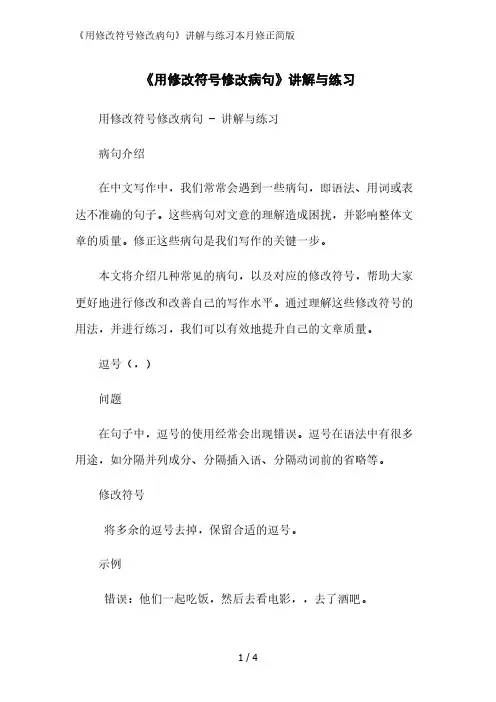
《用修改符号修改病句》讲解与练习用修改符号修改病句 - 讲解与练习病句介绍在中文写作中,我们常常会遇到一些病句,即语法、用词或表达不准确的句子。
这些病句对文意的理解造成困扰,并影响整体文章的质量。
修正这些病句是我们写作的关键一步。
本文将介绍几种常见的病句,以及对应的修改符号,帮助大家更好地进行修改和改善自己的写作水平。
通过理解这些修改符号的用法,并进行练习,我们可以有效地提升自己的文章质量。
逗号(,)问题在句子中,逗号的使用经常会出现错误。
逗号在语法中有很多用途,如分隔并列成分、分隔插入语、分隔动词前的省略等。
修改符号将多余的逗号去掉,保留合适的逗号。
示例错误:他们一起吃饭,然后去看电影,,去了酒吧。
修改:他们一起吃饭,然后去看电影,去了酒吧。
句号(。
)问题句号是中文写作中最常用的标点之一,用于表示句子的结束。
,有时候我们会不正确地使用句号,导致句子意思模糊或错误。
修改符号添加句号,确保每个句子都有明确的结束标志。
示例错误:我今天去买菜买了很多东西然后去超市还买了一件衣服修改:我今天去买菜买了很多东西。
然后去超市还买了一件衣服。
冒号(:)问题冒号在中文写作中的用法相对较少,常常出现错误的使用情况。
冒号可以用于引出例证、解释或提供并列信息等。
修改符号确保冒号后面的内容与前面的内容相互对应或解释。
示例错误:他对学习有很高的要求:每天要学一小时英语。
修改:他对学习有很高的要求:每天要学一小时英语。
省略号(……)问题省略号在中文写作中被过度使用,导致文本缺乏逻辑性和准确性。
省略号应当用于表示引文缺失、未完句或暂停等情况。
修改符号尽量减少使用省略号,只在确有需要的情况下使用。
示例错误:我昨天去超市买了一些水果,还有牛奶……还有一些其他东西……然后回家了。
修改:我昨天去超市买了一些水果,还有牛奶,以及其他一些东西,然后回家了。
感叹号(!)问题感叹号在中文写作中使用不当,容易给人过于情绪化或夸张的感觉。
修改符号减少感叹号的使用,只在确实需要强调的地方使用。
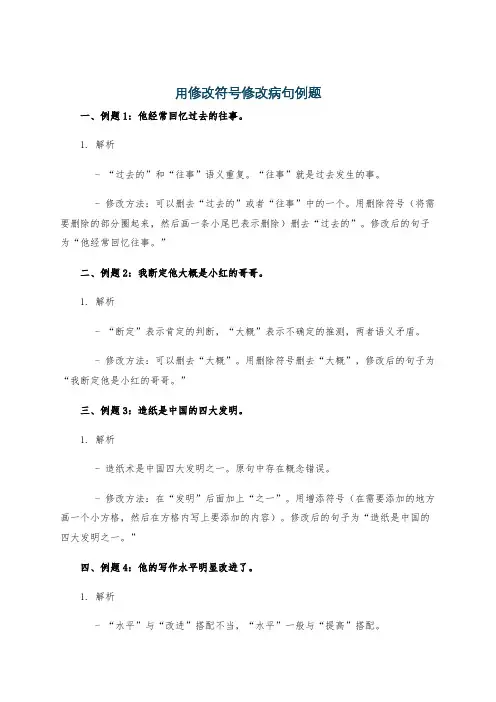
用修改符号修改病句例题
一、例题1:他经常回忆过去的往事。
1. 解析
- “过去的”和“往事”语义重复。
“往事”就是过去发生的事。
- 修改方法:可以删去“过去的”或者“往事”中的一个。
用删除符号(将需要删除的部分圈起来,然后画一条小尾巴表示删除)删去“过去的”。
修改后的句子为“他经常回忆往事。
”
二、例题2:我断定他大概是小红的哥哥。
1. 解析
- “断定”表示肯定的判断,“大概”表示不确定的推测,两者语义矛盾。
- 修改方法:可以删去“大概”。
用删除符号删去“大概”,修改后的句子为“我断定他是小红的哥哥。
”
三、例题3:造纸是中国的四大发明。
1. 解析
- 造纸术是中国四大发明之一。
原句中存在概念错误。
- 修改方法:在“发明”后面加上“之一”。
用增添符号(在需要添加的地方画一个小方格,然后在方格内写上要添加的内容)。
修改后的句子为“造纸是中国的四大发明之一。
”
四、例题4:他的写作水平明显改进了。
1. 解析
- “水平”与“改进”搭配不当,“水平”一般与“提高”搭配。
- 修改方法:将“改进”换成“提高”。
用替换符号(将需要替换的词语圈起来,然后在旁边写上替换的词语)把“改进”替换为“提高”。
修改后的句子为“他的写作水平明显提高了。
”。
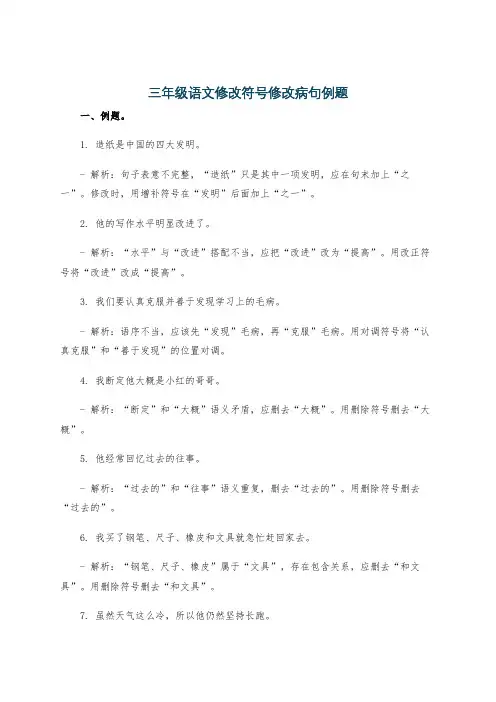
三年级语文修改符号修改病句例题一、例题。
1. 造纸是中国的四大发明。
- 解析:句子表意不完整,“造纸”只是其中一项发明,应在句末加上“之一”。
修改时,用增补符号在“发明”后面加上“之一”。
2. 他的写作水平明显改进了。
- 解析:“水平”与“改进”搭配不当,应把“改进”改为“提高”。
用改正符号将“改进”改成“提高”。
3. 我们要认真克服并善于发现学习上的毛病。
- 解析:语序不当,应该先“发现”毛病,再“克服”毛病。
用对调符号将“认真克服”和“善于发现”的位置对调。
4. 我断定他大概是小红的哥哥。
- 解析:“断定”和“大概”语义矛盾,应删去“大概”。
用删除符号删去“大概”。
5. 他经常回忆过去的往事。
- 解析:“过去的”和“往事”语义重复,删去“过去的”。
用删除符号删去“过去的”。
6. 我买了钢笔、尺子、橡皮和文具就急忙赶回家去。
- 解析:“钢笔、尺子、橡皮”属于“文具”,存在包含关系,应删去“和文具”。
用删除符号删去“和文具”。
7. 虽然天气这么冷,所以他仍然坚持长跑。
- 解析:关联词搭配不当,“虽然”与“但是”搭配,“因为”与“所以”搭配,这里应把“所以”改为“但是”。
用改正符号将“所以”改成“但是”。
8. 联欢会上,同学们唱了许多动听的歌和舞蹈。
- 解析:“唱”与“舞蹈”搭配不当,应删去“和舞蹈”或者在“舞蹈”前面加上“跳了”。
这里我们用删除符号删去“和舞蹈”。
9. 我断定他大概是小红的哥哥。
- 解析:“断定”表示肯定的判断,“大概”表示不确定,二者语义矛盾,删去“大概”。
用删除符号删去“大概”。
10. 造纸是中国的四大发明。
- 解析:句子表意不完整,造纸只是四大发明中的一项,应在句末加上“之一”。
用增补符号在“发明”后加上“之一”。
11. 他完成了一次又一次的艰巨任务。
- 解析:语序不当,应改为“他一次又一次地完成了艰巨任务”。
用对调符号将“完成了”和“一次又一次”的位置对调。
12. 我断定他可能生病了。
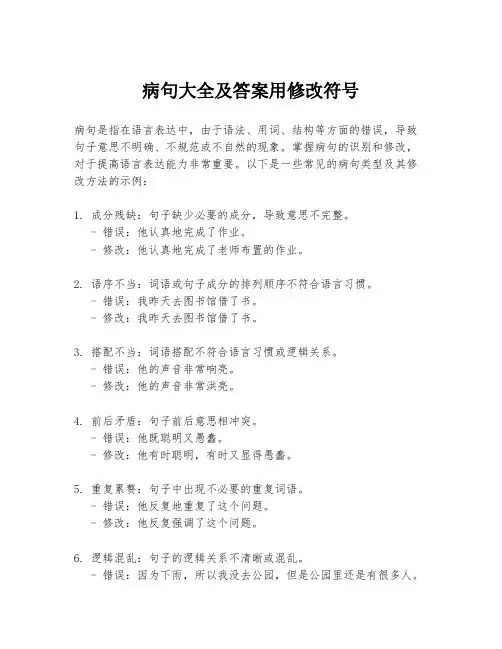
病句大全及答案用修改符号病句是指在语言表达中,由于语法、用词、结构等方面的错误,导致句子意思不明确、不规范或不自然的现象。
掌握病句的识别和修改,对于提高语言表达能力非常重要。
以下是一些常见的病句类型及其修改方法的示例:1. 成分残缺:句子缺少必要的成分,导致意思不完整。
- 错误:他认真地完成了作业。
- 修改:他认真地完成了老师布置的作业。
2. 语序不当:词语或句子成分的排列顺序不符合语言习惯。
- 错误:我昨天去图书馆借了书。
- 修改:我昨天去图书馆借了书。
3. 搭配不当:词语搭配不符合语言习惯或逻辑关系。
- 错误:他的声音非常响亮。
- 修改:他的声音非常洪亮。
4. 前后矛盾:句子前后意思相冲突。
- 错误:他既聪明又愚蠢。
- 修改:他有时聪明,有时又显得愚蠢。
5. 重复累赘:句子中出现不必要的重复词语。
- 错误:他反复地重复了这个问题。
- 修改:他反复强调了这个问题。
6. 逻辑混乱:句子的逻辑关系不清晰或混乱。
- 错误:因为下雨,所以我没去公园,但是公园里还是有很多人。
- 修改:虽然下雨,我没去公园,但是公园里还是有很多人。
7. 主谓不一致:主语和谓语在人称或数上不一致。
- 错误:这本书的内容非常丰富。
- 修改:这本书的内容非常丰富。
8. 用词不当:使用不恰当的词语,导致句子意思不准确。
- 错误:他对这个提议表示了赞同。
- 修改:他对这个提议表示了支持。
9. 指代不清:代词指代的对象不明确。
- 错误:小明和小红吵架了,他很生气。
- 修改:小明和小红吵架了,小明很生气。
10. 结构混乱:句子结构混乱,导致意思不清晰。
- 错误:虽然他很努力,但是成绩还是不理想。
- 修改:尽管他很努力,成绩还是不理想。
通过以上示例,我们可以看到,病句的修改需要我们对语言的敏感度和对语法规则的掌握。
在实际应用中,我们应多读多写,不断提高自己的语言表达能力,避免出现病句。
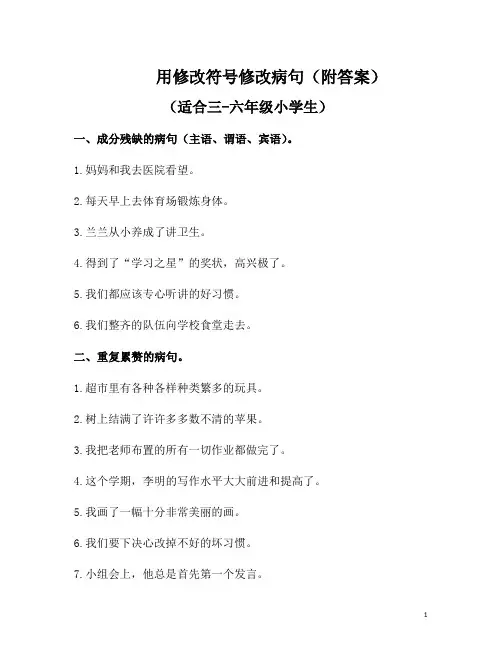
用修改符号修改病句(附答案)(适合三-六年级小学生)一、成分残缺的病句(主语、谓语、宾语)。
1.妈妈和我去医院看望。
2.每天早上去体育场锻炼身体。
3.兰兰从小养成了讲卫生。
4.得到了“学习之星”的奖状,高兴极了。
5.我们都应该专心听讲的好习惯。
6.我们整齐的队伍向学校食堂走去。
二、重复累赘的病句。
1.超市里有各种各样种类繁多的玩具。
2.树上结满了许许多多数不清的苹果。
3.我把老师布置的所有一切作业都做完了。
4.这个学期,李明的写作水平大大前进和提高了。
5.我画了一幅十分非常美丽的画。
6.我们要下决心改掉不好的坏习惯。
7.小组会上,他总是首先第一个发言。
三、用词不当的病句。
1.我要连续努力,争取更大进步。
2.我把教室打扫得整整齐齐。
3.我们要做到节约用水的好习惯。
4.宽敞的草原一望无边。
5.联欢会上,大家表演了一个个精致的节目。
四、前后颠倒的病句。
1.田野里吹来稻花香一阵。
2.爸爸讲了许多王兰老师动人的故事。
3.英语学科对我很感兴趣。
4.朝霞被天空映红了。
5.这是一本我的很有趣味的书。
五、前后矛盾的病句。
1.我今天上午做了一天的家庭作业。
2.卖火柴的小女孩的一双手几乎完全冻僵了。
3.警察叔叔很勇敢,我要向她学习。
4.广场上飘着五颜六色的红旗帜。
5.这次语文测试,我敢肯定小华可能得到满分。
六、修改病句综合练习。
1.玲玲和我热烈地握手。
2.我们要改掉挑食、偏食的坏习气。
3.我几乎全部会背诵“八礼四仪”的内容了。
4、我们班的竞赛得了全校第一名。
5.王老师推开门,走近教室。
6.宽敞的教室里,都在认真听课。
7.下课了,校园里顿时一下子沸腾了。
8.上课的时候,发言很积极。
9.在“文明小天使”活动中,使我受到了很大的教育。
10.听了王校长的报告,受到了教育。
11我喜欢吃的水果有苹果、草莓、荔枝、梨子等。
12.下雨了,我们撑着五颜六色的红伞回家了。
13.我把客厅打扫得整整齐齐。
14.听到这个好消息,高兴得跳起来。
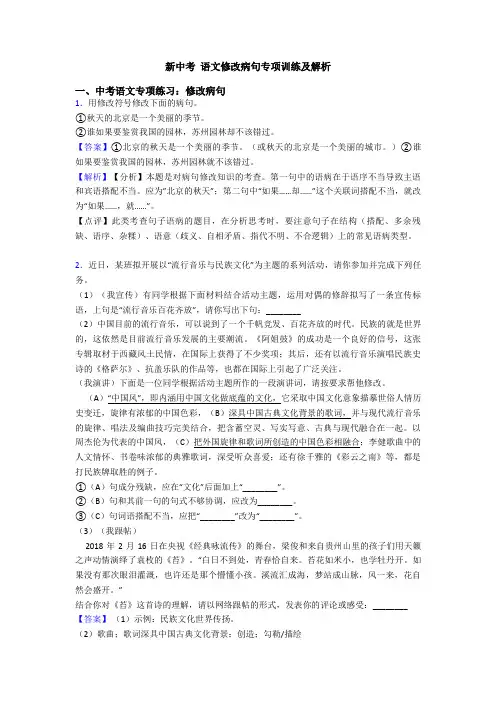
新中考语文修改病句专项训练及解析一、中考语文专项练习:修改病句1.用修改符号修改下面的病句。
①秋天的北京是一个美丽的季节。
②谁如果要鉴赏我国的园林,苏州园林却不该错过。
【答案】①北京的秋天是一个美丽的季节。
(或秋天的北京是一个美丽的城市。
)②谁如果要鉴赏我国的园林,苏州园林就不该错过。
【解析】【分析】本题是对病句修改知识的考查。
第一句中的语病在于语序不当导致主语和宾语搭配不当。
应为”北京的秋天”;第二句中“如果……却……”这个关联词搭配不当,就改为“如果……,就……”。
【点评】此类考查句子语病的题目,在分析思考时,要注意句子在结构(搭配、多余残缺、语序、杂糅)、语意(歧义、自相矛盾、指代不明、不合逻辑)上的常见语病类型。
2.近日,某班拟开展以“流行音乐与民族文化”为主题的系列活动,请你参加并完成下列任务。
(1)(我宣传)有同学根据下面材料结合活动主题,运用对偶的修辞拟写了一条宣传标语,上句是“流行音乐百花齐放”,请你写出下句:________(2)中国目前的流行音乐,可以说到了一个千帆竞发、百花齐放的时代。
民族的就是世界的,这依然是目前流行音乐发展的主要潮流。
《阿姐鼓》的成功是一个良好的信号,这张专辑取材于西藏风土民情,在国际上获得了不少奖项;其后,还有以流行音乐演唱民族史诗的《格萨尔》、抗盖乐队的作品等,也都在国际上引起了广泛关注。
(我演讲)下面是一位同学根据活动主题所作的一段演讲词,请按要求帮他修改。
(A)“中国风”,即内涵用中国文化做底蕴的文化,它采取中国文化意象描摹世俗人情历史变迁,旋律有浓郁的中国色彩,(B)深具中国古典文化背景的歌词,并与现代流行音乐的旋律、唱法及编曲技巧完美结合,把含蓄空灵、写实写意、古典与现代融合在一起。
以周杰伦为代表的中国风,(C)把外国旋律和歌词所创造的中国色彩相融合;李健歌曲中的人文情怀、书卷味浓郁的典雅歌词,深受听众喜爱;还有徐千雅的《彩云之南》等,都是打民族牌取胜的例子。
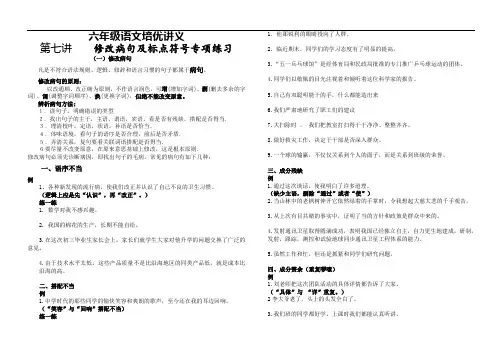
六年级语文培优讲义第七讲修改病句及标点符号专项练习(一)修改病句凡是不符合语法规则、逻辑、修辞和语言习惯的句子都属于病句。
修改病句的原则:以改通顺、改正确为原则,不作语言润色,可增(增加字词)、删(删去多余的字词)、调(调整字词顺序)、换(更换字词),但绝不能改变原意。
辨析病句方法:1.读句子,明确错误的类型2.找出句子的主干,主语,谓语,宾语,看是否有残缺,搭配是否得当.3.理清枝叶,定语,状语,补语是否恰当.4.体味语境,看句子的语序是否合理,前后是否矛盾.5.弄清关系,复句要看关联词语搭配是否得当.6要尽量不改变原意,在原来意思基础上修改,这是根本原则.修改病句必须先诊断病因,即找出句子的毛病。
常见的病句有如下几种:一、语序不当例1、各种新发现的流行病,使我们改正并认识了自己不良的卫生习惯。
(逻辑上应是先“认识”,再“改正”。
)练一练1.数学对我不感兴趣。
2.我国的棉花的生产,长期不能自给。
3.在这次初三毕业生家长会上,家长们就学生大家对他升学的问题交换了广泛的意见。
4.由于技术水平太低,这些产品质量不是比沿海地区的同类产品低,就是成本比沿海的高。
二、搭配不当例1.中学时代的那些同学的愉快笑容和爽朗的歌声,至今还在我的耳边回响。
(“笑容”与“回响”搭配不当)练一练1.他那锐利的眼睛投向了人群。
2.临近期末,同学们的学习态度有了明显的提高。
3.“五一兵乓球馆”是经体育局和民政局批准的专门推广乒乓球运动的团体。
4.同学们以敬佩的目光注视着和倾听着这位科学家的报告。
5.自己有双聪明能干的手,什么都能造出来6.我们严肃地研究了职工们的建议7.大扫除时,我们把教室打扫得干干净净、整整齐齐。
8.做好救灾工作,决定于干部是否深入群众。
9.一个球的输赢,不仅仅关系到个人的面子,而是关系到班级的荣誉。
三、成分残缺例1.通过这次谈话,使我明白了许多道理。
(缺少主语,删除“通过”或者“使”)2.当山林中的老枫树伸开它依然绿着的手掌时,令我想起大慈大悲的千手观音。
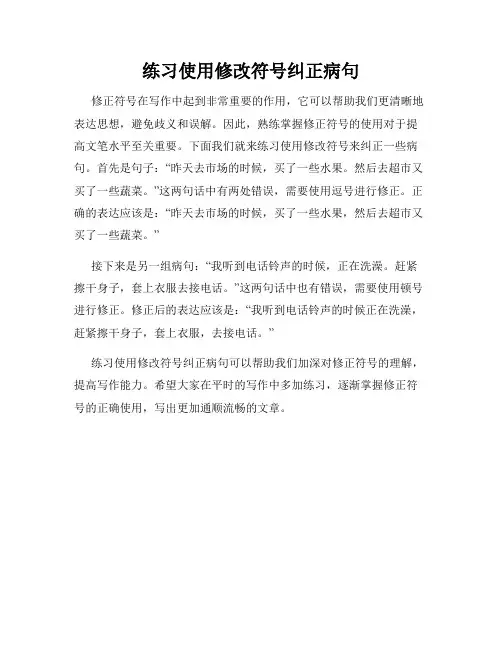
练习使用修改符号纠正病句修正符号在写作中起到非常重要的作用,它可以帮助我们更清晰地表达思想,避免歧义和误解。
因此,熟练掌握修正符号的使用对于提高文笔水平至关重要。
下面我们就来练习使用修改符号来纠正一些病句。
首先是句子:“昨天去市场的时候,买了一些水果。
然后去超市又买了一些蔬菜。
”这两句话中有两处错误,需要使用逗号进行修正。
正确的表达应该是:“昨天去市场的时候,买了一些水果,然后去超市又买了一些蔬菜。
”
接下来是另一组病句:“我听到电话铃声的时候,正在洗澡。
赶紧擦干身子,套上衣服去接电话。
”这两句话中也有错误,需要使用顿号进行修正。
修正后的表达应该是:“我听到电话铃声的时候正在洗澡,赶紧擦干身子,套上衣服,去接电话。
”
练习使用修改符号纠正病句可以帮助我们加深对修正符号的理解,提高写作能力。
希望大家在平时的写作中多加练习,逐渐掌握修正符号的正确使用,写出更加通顺流畅的文章。
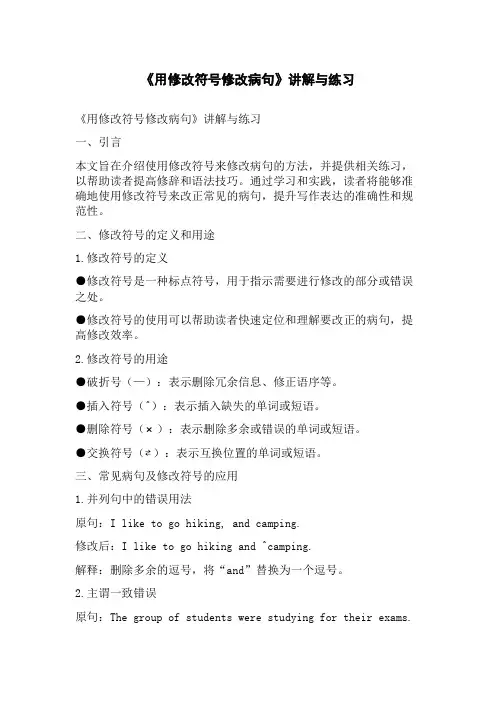
《用修改符号修改病句》讲解与练习《用修改符号修改病句》讲解与练习一、引言本文旨在介绍使用修改符号来修改病句的方法,并提供相关练习,以帮助读者提高修辞和语法技巧。
通过学习和实践,读者将能够准确地使用修改符号来改正常见的病句,提升写作表达的准确性和规范性。
二、修改符号的定义和用途1.修改符号的定义●修改符号是一种标点符号,用于指示需要进行修改的部分或错误之处。
●修改符号的使用可以帮助读者快速定位和理解要改正的病句,提高修改效率。
2.修改符号的用途●破折号(—):表示删除冗余信息、修正语序等。
●插入符号(^):表示插入缺失的单词或短语。
●删除符号(⨯):表示删除多余或错误的单词或短语。
●交换符号(⇄):表示互换位置的单词或短语。
三、常见病句及修改符号的应用1.并列句中的错误用法原句:I like to go hiking, and camping.修改后:I like to go hiking and ^camping.解释:删除多余的逗号,将“and”替换为一个逗号。
2.主谓一致错误原句:The group of students were studying for their exams.修改后:The group of students was studying for ^its exams.解释:将动词“were”改为“was”,将代词“their”改为“its”,使其与“group”保持一致。
3.使用不当的冠词原句:She is going to college to learn a engineering.修改后:She is going to college to learn ^engineering.解释:删除不必要的冠词“a”。
4.缺少主语或谓语原句:Walked to the park.修改后:He walked to the park.解释:添加主语“he”。
四、练习题请根据下列句子中标记的部分,使用适当的修改符号进行修正。
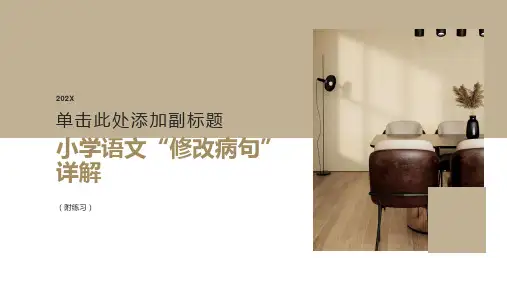
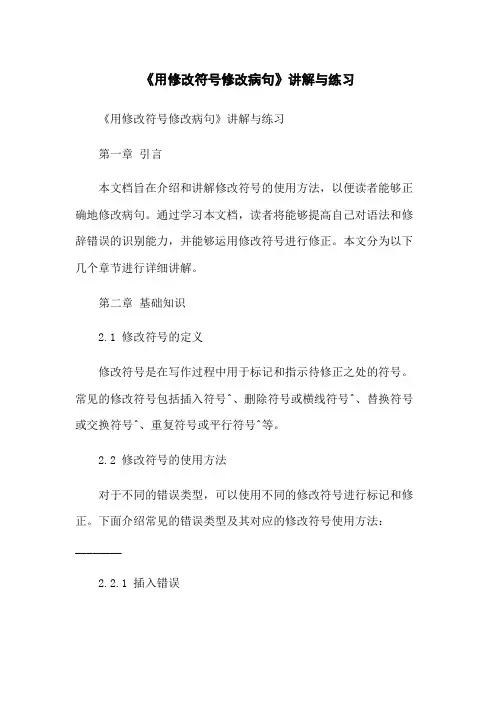
《用修改符号修改病句》讲解与练习《用修改符号修改病句》讲解与练习第一章引言本文档旨在介绍和讲解修改符号的使用方法,以便读者能够正确地修改病句。
通过学习本文档,读者将能够提高自己对语法和修辞错误的识别能力,并能够运用修改符号进行修正。
本文分为以下几个章节进行详细讲解。
第二章基础知识2.1 修改符号的定义修改符号是在写作过程中用于标记和指示待修正之处的符号。
常见的修改符号包括插入符号^、删除符号或横线符号^、替换符号或交换符号^、重复符号或平行符号^等。
2.2 修改符号的使用方法对于不同的错误类型,可以使用不同的修改符号进行标记和修正。
下面介绍常见的错误类型及其对应的修改符号使用方法:________2.2.1 插入错误当句子中缺少某个词或短语时,可以使用插入符号^表示需要添加的内容。
例如:________“他^在外面玩,忘记了约定。
”2.2.2 删除错误当句子中多余的词或短语需要删除时,可以使用删除符号或横线符号^表示需要删除的内容。
例如:________“他们正在讨论一个重要的-问题。
”2.2.3 替换错误当句子中某个词或短语需要被替换时,可以使用替换符号或交换符号^表示需要替换的内容,并使用括号或方括号括起来表示替换后的内容。
例如:________“他(她)是一位优秀的教师。
”2.2.4 重复错误当句子中某个词或短语重复出现时,可以使用重复符号或平行符号^表示重复内容。
例如:________“他要去去超市买些食品。
”第三章常见错误类型及修改方法3.1 主谓不一致3.2 时态错误3.3 语态错误3.4 并列结构错误3.5 修辞错误第四章练习题4.1 单项选择题4.2 完形填空题4.3 改正下列句子中的错误附件:________本文档配有练习题和答案解析。
法律名词及注释:________1.修改符号:________在写作中用于标记和指示待修正之处的符号,如插入符号^、删除符号或横线符号^、替换符号或交换符号^、重复符号或平行符号^等。
用修改符号修改病句一、背景介绍编辑文章时,我们常常会遇到一些病句,这些病句可能会影响文章的质量和可读性。
而在修正这些病句时,使用修改符号(即使用特定的符号将错误内容标注出来)是一种常用的方式。
本文将介绍修改符号的使用方法,并通过练习帮助读者掌握这一技巧。
二、修改符号的使用方法1. 删除符号(~~):用于删除错误的词或短语。
例如:“这个问题是由于~~一个简单的错误导致的。
”2. 插入符号(^):用于插入缺失的词或短语。
例如:“她是一位^很优秀的学生。
”3. 替换符号(-):用于替换错误的词或短语。
例如:“这个问题其实是由于错误的-方法导致的。
”4. 修改符号(∧):用于调整词或短语的位置。
例如:“她是一位优秀∧的学生。
”三、练习题请按照上述修改符号的使用方法,对以下病句进行修正:1. 这篇文章写的非常好2. 她是一个非常聪明的幼儿教师3. 我们打算在周末去爬山4. 他是这个团队中最重要的一员5. 我们经常用方式沟通6. 昨天我在公园里碰到了他7. 这个问题其实是由于我的错误导致的8. 这个活动包含了很多有趣的项目四、答案解析1. 这篇文章写的非常好。
2. 她是一个非常聪明的^幼儿教师。
3. 我们打算在周末去∧爬山。
4. 他是这个团队中最重要的一∧员。
5. 我们经常用方式∧沟通。
6. 昨天我在公园里碰到了^他。
7. 这个问题其实是由于我的错误∧导致的。
8. 这个活动包含了很多有趣的^项目。
五、通过本文的讲解与练习,我们可以掌握使用修改符号修正病句的技巧。
在实际写作或编辑中,我们可以灵活运用这些符号,以提升文章的质量与可读性。
希望本文对你有所帮助,谢谢阅读!。
《用修改符号修改病句》讲解与练习在我们的语文学习中,修改病句是一项重要的技能。
它不仅能够帮助我们提高语言表达的准确性,还能让我们的文字更加通顺、流畅。
接下来,让我们一起来学习如何用修改符号修改病句吧!一、常见的病句类型1、搭配不当句子中某些词语在意义上不能相互搭配或者搭配起来不符合语言习惯。
例如:“他的写作水平明显改进了。
”这里“水平”和“改进”搭配不当,应将“改进”改为“提高”。
2、成分残缺句子缺少了某些必要的成分,导致意思表达不完整。
比如:“通过这次活动,使我们受到了很大的教育。
”这个句子缺少主语,应删去“通过”或“使”。
3、重复啰嗦句子中某些词语或内容重复,显得啰嗦。
像:“他大约四十岁上下。
”“大约”和“上下”意思重复,可删去其一。
4、语序不当句子中词语的顺序排列不当,影响了句子的意思。
例如:“我们要不断改进学习方法,增加学习效率。
”应将“增加”改为“提高”,并且把“改进学习方法”和“提高学习效率”的顺序调换。
5、前后矛盾句子前后表达的意思自相矛盾。
比如:“我断定他可能生病了。
”“断定”表示肯定,“可能”表示不确定,两者矛盾,应删去“可能”。
6、用词不当句子中使用了不恰当的词语。
例如:“这篇童话对我产生了兴趣。
”应将“对”改为“让”。
二、修改符号1、改正号用来改正错别字、错误的标点符号以及错误的词语等。
2、删除号用于删除多余的字、词、句、标点等。
3、增补号用来增补缺少的字、词、标点等。
4、对调号用于相邻的词语、句子或段落交换位置。
5、移动号用于将某些内容移动到指定的位置。
三、修改病句的步骤1、读句子首先要认真地把句子读几遍,理解句子的意思,找出句子存在的问题。
2、找病因根据常见的病句类型,分析句子出现的毛病属于哪一种类型。
3、改病句运用修改符号,针对病因进行修改。
4、再读句子修改完病句后,要再读几遍句子,检查修改后的句子是否通顺、合理,意思是否表达清楚。
四、练习下面我们来做一些练习,巩固一下所学的知识。
小学语文修改病句讲解与练习(综合)病句中的常见错误1.词语搭配不当;2.句子重复;3.句子顺序颠倒;4.关联词语用错;5.缺少句子成分。
1.前后矛盾6.语序错误7.字词错误1.用修改符号修改(用于前后矛盾、语句重复、语序错误、字词错误、语句顺序颠倒、关联词应用错误、用词不当1.病句是指结构不完整,意思表达得不明确、不清楚,有错误的句子。
进行修改病句训练的目的是认清写句子时容易犯的错误,使自己少写和不写病句,把意思表达得明确、通顺。
本年级常见的病句有以下几种情况:(1)成分残缺:这种句子缺少必要的成分、意思不完整。
如:“放声歌唱。
”同学们知道一个句子一般可以分为两部分,前一部分说的是“谁”或“什么”,后一部分说的是“是什么”、“做什么”或“怎么样”,这两个部分是句子的基本成分,缺一不可。
(2)意思重复:这种句子是前边说了一个意思,后边又重复说一遍,意思重复了。
如:“我把不正确的错别字改正过来了。
”这里“不正确”和“错别字”意思一样,连着用就显得重复多余。
(3)用词不当:这种句子是由于对词义理解不清、用错了近义词等,造成词不达意,违反了句子的结构规律。
如:“同学们热心欢迎新老师。
”“热心”一词的意思是:有热情、有兴趣、肯尽力,用在“欢迎”前面显然不合适。
(4)词序颠倒:词序是词语在句子中排列的顺序,这种顺序反映了词语在词句结构中所处的地位。
每一个词语在语言结构中都有它特定的位置,离开了自己的位置,就犯了词序不当的毛病。
如:“今年的麦子丰收在望,长势喜人。
”小麦长势喜人,才能丰收在望,词序颠倒了就不符合客观规律了。
2.修改病句的步骤。
(1)读懂原句,弄清本意。
首先要仔细读病句,弄明白它要表达的主要意思。
(2)查找病因,确定病症。
围绕句子的主要意思找出病句的原因所在,弄懂属于哪种类型的病句。
(3)对症下药,修改病句。
弄清病因后,要针对句子存在的问题,想好删去什么、添上什么、更换什么,然后动手改病句。
(4)仔细检查,完成练习。
中考修改病句技巧习题训练一、中考语文专项练习:修改病句1.用修改符号修改下面的病句。
①秋天的北京是一个美丽的季节。
②谁如果要鉴赏我国的园林,苏州园林却不该错过。
【答案】①北京的秋天是一个美丽的季节。
(或秋天的北京是一个美丽的城市。
)②谁如果要鉴赏我国的园林,苏州园林就不该错过。
【解析】【分析】本题是对病句修改知识的考查。
第一句中的语病在于语序不当导致主语和宾语搭配不当。
应为”北京的秋天”;第二句中“如果……却……”这个关联词搭配不当,就改为“如果……,就……”。
【点评】此类考查句子语病的题目,在分析思考时,要注意句子在结构(搭配、多余残缺、语序、杂糅)、语意(歧义、自相矛盾、指代不明、不合逻辑)上的常见语病类型。
2.语段修改。
①因为认知到自我的局限与狭隘,并了解到世界的广大与多元,②所以允许自己不懂得他人,________________;③所以不试图凌驾他人的意志,也不轻易置身于他人订立的评价体系,这大概就是最自由的孤独,最温柔的叛逆。
(1)第①句语序有误,请将修改后的句子写在下面的横线上。
(2)根据句意在第②句话横线上补一句话,使句子能衔接自然,符合整个句子的意境。
(3)第③句中的标点有错误,应改为:________。
【答案】(1)因为了解到世界的广大与多元,并认知到自我的局限与狭隘,(2)也允许他人不懂得自己(3)所以不试图凌驾他人的意志,也不轻易置身于他人订立的评价体系——这大概就是最自由的孤独,最温柔的叛逆。
【解析】【分析】(1)这句话是一个递进句,后面的句子意思比前面句子的意思更近一层,它按照从外到内的逻辑顺序写的,因此应该为:因为了解到世界的广大与多元,并认知到自我的局限与狭隘。
(2)根据横线前面的句子“允许自己不懂得他人”和后面的句子“所以不试图凌驾他人的意志,也不轻易置身于他人订立的评价体系”可知,横线上应该填入的句子是:也允许他人不懂得自己。
(3)“这大概就是最自由的孤独,最温柔的叛逆”是对前一句的解释说明,中间应该用破折号。
2.我们看看课文是怎样修改的,用上了修改符号,把有毛病的句子改好了,多神奇啊!我们来认识这三种修改符号:改正符号、增补符号、删除符号。
改正符号可以改正错别字、词语等;增补符号表示增加添补内容;删除符号表示删去字、词、句和标点等。
〔三〕修改病句是有方法可寻的,完成四步走的方法步骤,就能成为一名合格的医生了。
1、读:读懂原句,弄清句意,本意是指原句所要表达的主要意思。
修改病句的前提是不能改变原句的本来意思,只有弄清句子的本意,才可能正确修改。
2、找:查找病因,确定病症。
要修改病句,先要找到句子的病症,确定病因。
一般我们可以根据所学过的几种病句的常见原因,帮助查找病症。
病句的八种常见类型:用词不当、搭配不当、前后矛盾、语序不当、重复啰嗦、成分残缺、分类不当、标点错误。
给句子缩句,也可快速找到病症:谁是什么。
谁做了什么事。
谁怎么样了。
3、改:对症下药,修改病句,保原意。
根据语句的病症及原因,经过认真思考,运用修改符号,采用增、删、调、换等方法,动手把错的地方改正。
进行换一换,就是替换不恰当的内容;增一增,就是增添残缺的句子成分;删一删,就是删去多余及错误的词语。
调一调,就是调换字句词位置。
4、查:细致检查。
改完后,还得要重读一两遍,看看有毛病的地方是否都修改了,修改得是否恰当,是否保持了句子的原意。
〔四〕修改原那么:保持原意,力求少改,按要求修改,符合语法标准。
修改病句的原那么是不改变句子的原意,同时以最简洁的方法修改。
因此修改前必须先读懂句子,明确句子表达的意思,找到病因后修改,修改后还要细致检查,因为有的病句有几处毛病,还要看有没有将意思表达清楚,有的病句有几种修改方法,只要表达清楚就行。
语文修改病句常用修改符号一、常用修改符号
二、用修改符号修改病句举例
三、练习使用修改符号修改病句
1.中国的人口是世界上最多的国家。
2.她很果断,从来不听别人的意见。
3.星期天,我们来到刚建成的、崭新的儿童公园。
4.今天的家庭作业是读二遍课文和四道数学题。
5.多读课外书,可以使我们增长知识和写作水平。
6.每个小学生都应该上课专心听讲的好习惯。
7.经过刻苦学习,晓红取得了优异的成就。
8.因为老舍爱养花,而且养了很多花。
9.这本书对我很感兴趣。
10.造纸是我国古代四大发明。
11.我国有世界上独一无二举世无双的万里长城。
12.篮子里有青菜、萝卜、葡萄、西红柿等蔬菜。
13.春天来了,桃花、梨花、腊梅……竞相开放。
14.正在仔细地批改作业。
15.红军长征时期的生活非常艰巨。
16.他的写作水平有了明显的改进。
17.集邮对我特别感兴趣。
18.我写得一扁作文“我爱故乡”在作文竞赛中获奖了。
晚上,我激动地心情翻开日记本,想象着发奖时的情景就像电影一样一幕幕出现在眼前。
当时,老师亲切的对我说:“希望你再接再厉,争取更大的成就。
”。